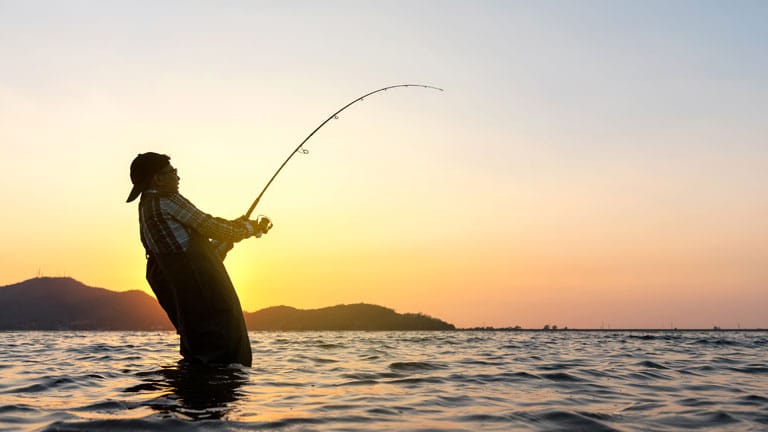Learn how to fish for bass from shore if you are an avid angler looking to expand your knowledge of fishing techniques. It’s no surprise that bass fishing is a popular activity in North America. It’s not only easy to catch these fish, but they’re also delicious.
Fishing from Shore: Understanding Seasonal Bass Habits
Fishing from shore presents a unique challenge for anglers seeking bass, and success hinges on understanding the seasonal habits of these elusive freshwater predators. Bass behavior undergoes significant changes throughout the year, and mastering these patterns is key to a fruitful shoreline angling experience. Understanding how to fish for bass from shore requires knowledge of the weather.
Spring Feeding Frenzy:
As winter retreats and temperatures rise, bass in spring transition into an aggressive feeding mode. As bass move closer to shore, shallow waters become hotspots, actively pursuing baitfish and spawning prey. Targeting these areas with lures mimicking juvenile fish or crawfish can yield impressive results during the spring feeding frenzy.
Summer Retreats to Structure:
As the mercury climbs, bass tend to seek refuge in deeper waters or shaded structures. During summer, focus on submerged structures like fallen trees, rocks, or docks along the shoreline. Casting near these structures with topwater lures or plastic worms can entice bass looking for both shelter and an easy meal.
Fall Transition and Migration:
As autumn arrives, bass undergo a transition, preparing for the colder months. Shoreline anglers should follow the movement of baitfish schools, as bass embark on a migration towards deeper waters. Targeting drop-offs and points with crankbaits or swimbaits mimicking injured baitfish can trigger aggressive strikes during this transitional period.
Winter’s Slow and Stealthy Approach:
In winter, bass activity slows, and they become more lethargic. Shoreline anglers need to adjust their tactics accordingly. Focus on slow presentations such as jigs or finesse worms, probing deeper waters where bass may congregate. Patience is paramount during winter fishing, as bass are less inclined to chase fast-moving lures in the cold.
How to fish for bass from shore? Best Techniques
You need some essential gear and the best techniques for bass fishing from shore. Here are some of the best techniques
1. Gear Preparation:
Selecting the right gear is crucial for shore fishing. A medium to medium-heavy spinning rod around 6 to 7 feet in length works well. Pair it with a quality spinning reel, spooled with 10-20lb test monofilament or fluorocarbon line. When fishing for big bass, don’t forget to bring a landing net.
2. Lure Choices:
Various lures can entice bass. Soft plastic worms, jigs, crankbaits, and spinnerbaits are effective from the shore. Opt for natural colors in clear water and brighter hues in murky conditions. Matching the local prey can increase your chances of success.
3. Location Scouting:
Explore the shoreline to identify potential bass hotspots. Look for structures like fallen trees, rocks, and submerged vegetation. These serve as hiding spots for bass. Pay attention to changes in water depth and any signs of baitfish activity.
4. Casting Techniques:
Mastering your casting technique is vital. Practice accurate casts to specific spots near structures. Use a sidearm cast or an underhand flip for precision. Be mindful of wind direction and adjust your casting angle accordingly.
5. Retrieval Strategies:
Experiment with different retrieval speeds and patterns. Bass can be responsive to a slow, steady retrieve or erratic movements that mimic injured prey. Vary your retrieval until you find what entices the bass on that particular day.
6. Time of Day Considerations:
Timing plays a role in bass activity. Early morning and late evening are prime times for shore fishing. Bass tend to be more active during these low-light periods. However, they can also be caught during the day, especially in overcast conditions.
7. Patience and Observation:
Patience is key in shore fishing. Take time to observe the water, noting any signs of bass activity. It might be a subtle ripple or a splash. Stay quiet and avoid unnecessary movements to prevent spooking the bass.
8. Safety Measures:
Prioritize safety while fishing from the shore. Be cautious of slippery rocks or uneven terrain. Wear appropriate footwear and bring a headlamp if fishing in low-light conditions. Additionally, check local regulations and obtain the necessary permits before fishing in a new location.
Summary
Despite what many people believe, bass can be caught without a fancy boat or high-tech gear. Whether from a bank, a pier, or a dock, shore fishing for bass is a fantastic way to catch bass. Bass fishing can be challenging, and you’ll probably come home empty-handed some days. It is possible to be a successful bass angler from shore with patience, persistence, and the right approach. You should now be able to easily explain how to fish for bass from shore if your friend or someone else asks.
Some of the links in this post are affiliate links. This means if you click a link and make a purchase we will receive an affiliate commission at no extra cost to you.
